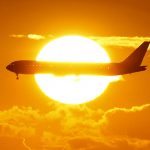What is cosmic radiation?
Cosmic radiation consists of energetic charged particles, such as protons and Helium ions, moving through space. They originate from events beyond our solar system and from the sun. When these particles enter the Earth’s atmosphere they collide with, and disrupt, atoms in our atmosphere, producing secondary, less intense, radiation. By the time cosmic radiation reaches the ground its intensity has been considerably reduced.
How important is cosmic radiation compared to other sources of radiation?
On the ground, cosmic radiation makes up on average about 17% of the natural background radiation to which we are all exposed. The rest consists of radon gas (50%), radiation from minerals in the soil (20%), and radiation in our bodies from food and water (13%). These proportions do vary, as does the total exposure, depending on geographic location because of differences in soil composition and altitude.
What determines the intensity of cosmic radiation?
The amount, or intensity, of cosmic radiation depends on altitude and latitude, as well as the stage of the solar cycle. The Earth’s atmosphere provides considerable protection from cosmic radiation. At commercial aircraft altitudes the protective layer of the Earth’s atmosphere is much thinner than it is on the ground and the intensity of cosmic radiation is approximately 100 times greater at these altitudes than it is on the ground.
The Earth’s magnetic field can deflect some of the cosmic radiation away from the Earth. The shielding ability of the magnetic field is most effective over the equator and least effective over the poles. The intensity of cosmic radiation at aircraft altitudes around the equator is about three times less than at the poles.
The sun’s magnetic field can also deflect cosmic radiation away from the Earth. The strength of the sun’s magnetic field varies with the approximate 11 year cycle of rise and decline of solar activity (solar cycle). When solar activity is low (solar minimum), the magnetic field is less effective in deflecting cosmic radiation; cosmic radiation reaching the Earth will be more intense during solar minimum. The effect of solar activity on intensity of cosmic radiation is much smaller than that caused by altitude or latitude. There is about a 40% decrease in intensity from solar minimum to solar maximum conditions.
The Sun ejects energetic particles, such as protons (solar flares), which may also contribute to the intensity of cosmic radiation. However, only on very infrequent occasions would solar flares have sufficient energy to increase the intensity of cosmic radiation at commercial aircraft altitudes.
How much exposure to cosmic radiation is there while flying at commercial aircraft altitudes?
The amount of exposure to cosmic radiation while flying depends on the time spent flying, in addition to the factors mentioned above – altitude, latitude and solar activity. Solar flares contribute very little to the overall exposure from cosmic radiation.
For occasional flyers the exposure to cosmic radiation is very small. For those who fly frequently, such as aircrew and some business travelers, the annual exposure may be comparable with, or even exceed, that of radiation workers in ground-based industries.
At commercial aircraft altitudes cosmic radiation is much more intense than on the ground. Even though exposure can be a hundred times greater at these altitudes than it is on the ground, it is still fairly small. It would take about 100 one-way flights between Toronto and Vancouver to obtain the same exposure as we get in one year from other sources of natural background radiation.
What are the potential health implications attributed to cosmic radiation exposure at commercial aircraft altitudes?
The only effect that is known to be possible at this level of exposure is a very slight increase in the chance of a cancer occurring many years, even decades after the exposure.
In theory, small exposures to radiation can start off chains of events that may lead to cancer many years later. The body’s repair mechanisms are usually able to fix the damage that is done before a cancer develops. While no level of exposure to radiation can be described as safe, at the same time, no level is uniformly dangerous. The chance of a cancer occurring is generally believed to be proportional to the level of radiation exposure: the lower the exposure, the lower the risk.
For example, the chance of a fatal cancer occurring would be approximately 1% following 30 years of flying, at 1000 hours per year. Most people fly much less and the chance of a fatal cancer occurring would also be much less. As we all have about a 25% chance of getting a fatal cancer, cosmic radiation represents a small addition to the underlying cancer risk from all causes.
Can cosmic radiation exposure at commercial aircraft altitudes harm an unborn child?
It is uncertain whether this level of exposure is sufficient to cause any harm to an unborn child. It is possible that this level of exposure may result in a slight increase in the chance of a cancer, such as leukemia, occurring in childhood, or later.
It is known that the unborn child is very sensitive to the effects of radiation and other agents. This is partly because the cells are rapidly dividing and growing into specialized cells and tissues. Interference in the process of development by any agent could result in birth defects or certain illnesses such as cancer. Birth defects are not expected to result from cosmic radiation at commercial aircraft altitudes because much higher levels of radiation exposure are needed to produce birth defects.
Most studies of unborn children exposed to low levels of radiation do not show any increase in the chance of a childhood cancer occurring. However, there is one large study which suggested a 0.1% chance of a childhood cancer occurring as a result of the radiation exposure. In comparison, the chance of a childhood cancer occurring from all causes is about 0.2-0.3%. The exposure in this study was roughly equivalent to flying 2000 hours. This level of exposure from cosmic radiation would not be very likely during pregnancy.
Because of the uncertainty concerning the magnitude of the risk at low levels of exposure, radiation protection authorities have recommended that the additional exposure to an unborn child be kept to a level which is similar to the variation in natural background radiation. This would equate to about 200 hours of flying. At this level of exposure no observable health effects are expected.
What are Health Canada’s recommendations?
Pregnant women who expect to fly more than 200 hours over the course of their pregnancy should seek further information from the Radiation Protection Bureau, Health Canada on the radiation risks for unborn children.
Information may be obtained by calling (613) 941-3320 or writing to the
Radiation Protection Bureau,
775 Brookfield Road
Locator 6302 C4,
Ottawa K1A 1C1.
References
B.J. Lewis et al, Cosmic radiation Exposure on Canadian-Based Commercial Airline Routes, Radiation Protection Dosimetry 86(1):7-24, 1999
European Radiation Dosimetry Group, Exposure of aircrew to cosmic radiation, EURADOS report 1996-01, European Commission,1996
Health Canada, 2000 Report on Occupational Radiation Exposures in Canada, 2000
International Commission on Radiological Protection. ICRP Publication 84: Pregnancy and Medical Radiation, Pergamon Press, 2000
United Nations Scientific Committee on the Effects of Atomic Radiation, Sources and Effects of Atomic Radiation: UNSCEAR 2000 Report to the General Assembly, United Nations, 2000
More From SolarStorms.org:
Submit your review | |







